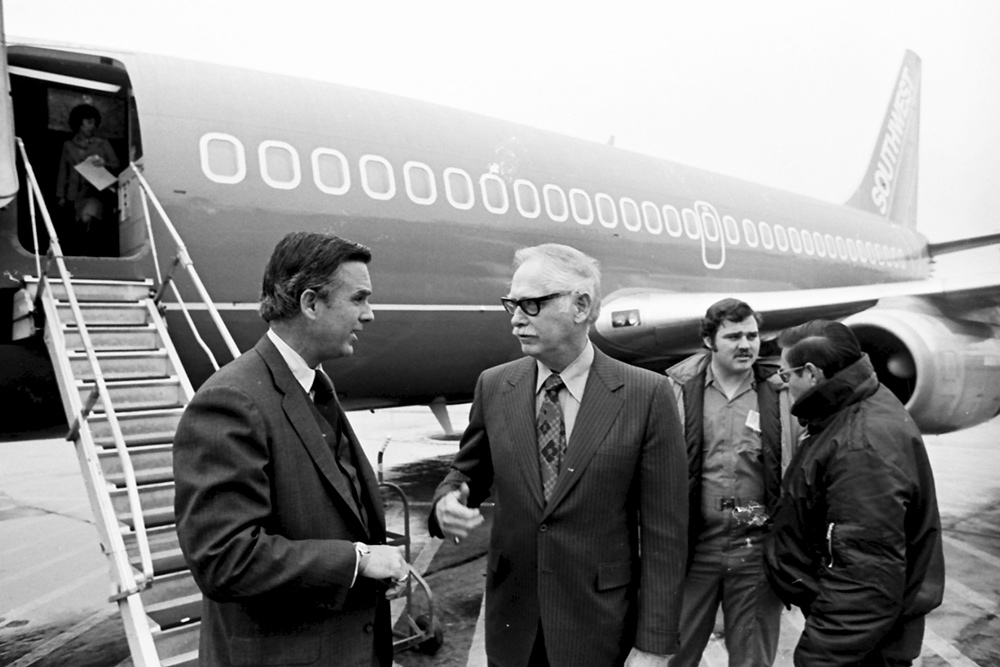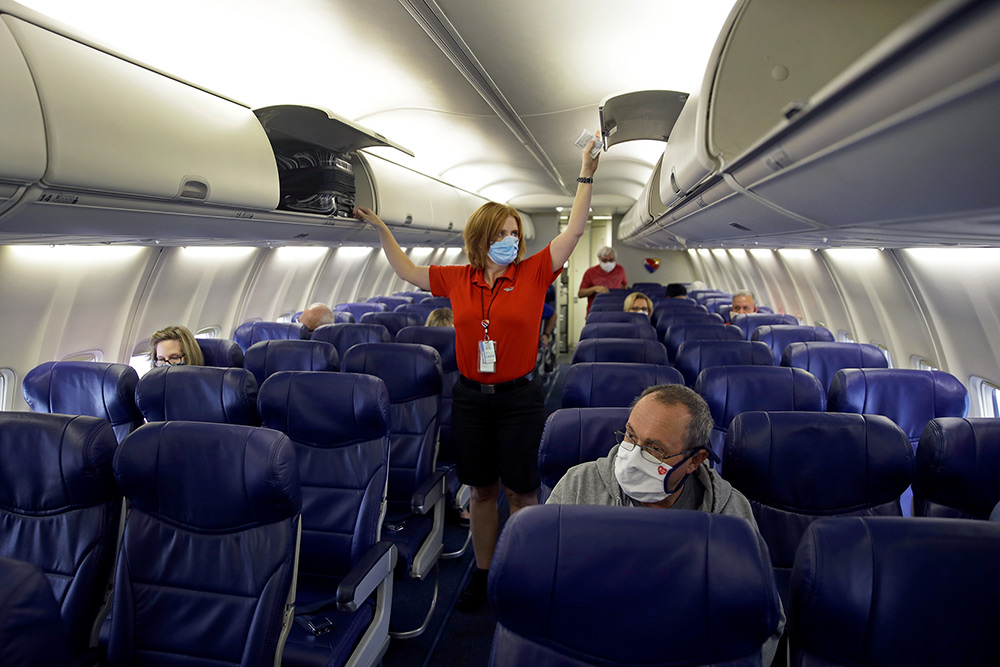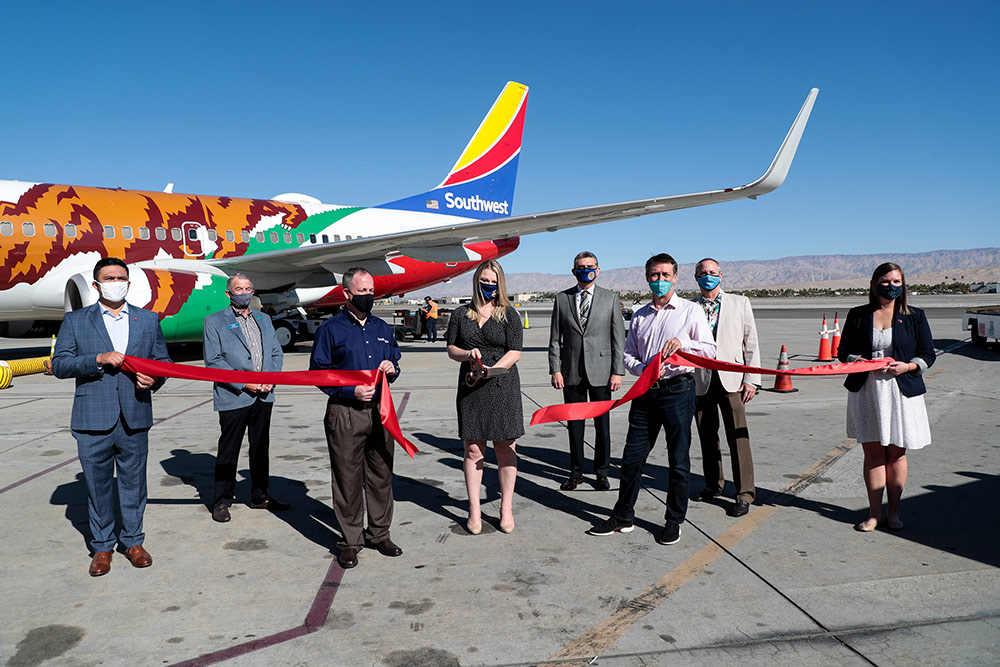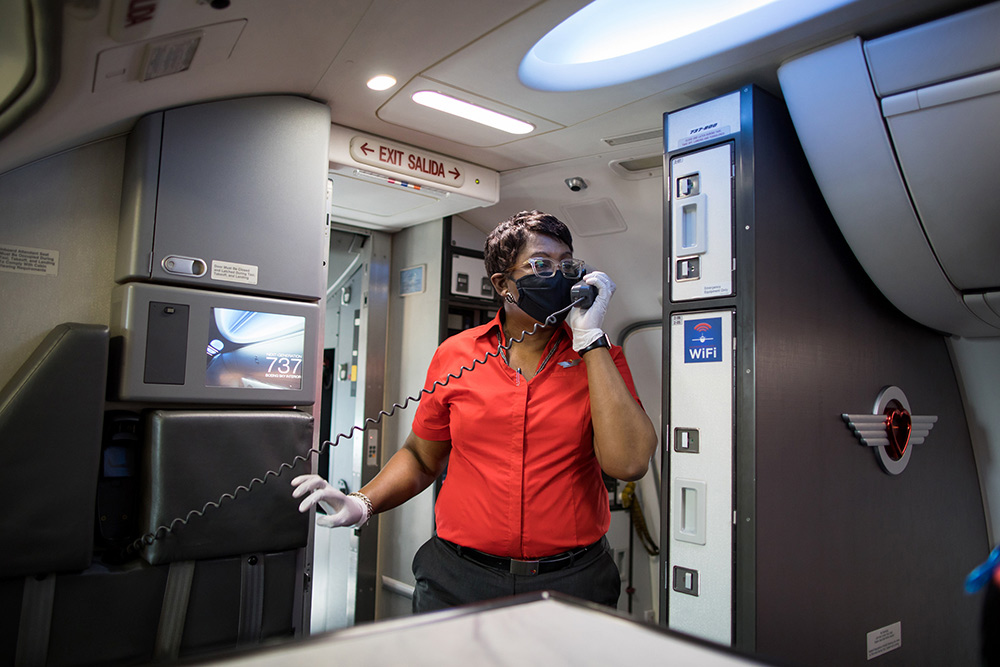當(dāng)時,,美國西南航空公司的首席執(zhí)行官加里?凱利眼前一片模糊,。去年4月擺在他面前的調(diào)查數(shù)據(jù)慘到難以言喻,而且無法預(yù)測新冠疫情意味著暫時下跌還是緩慢衰退,。
“每周財務(wù)團(tuán)隊(duì)發(fā)給我業(yè)務(wù)數(shù)據(jù)時,,通常都會提供一些偏樂觀的評論?!彼嬖V《財富》雜志,。
但2020年4月5日這一周報告的“色調(diào)”讓人異常難過?!拔覐奈从龅截攧?wù)人員發(fā)出如此悲傷的信息,。報告中說:‘損失已經(jīng)無法用語言來描述。我們?nèi)绾尾拍軌驈?fù)蘇,?’”
看到2019年航空流量下降97%,,而當(dāng)周現(xiàn)金消耗達(dá)2億美元,凱利不禁產(chǎn)生了同樣的疑問,。他回憶說,,美國世貿(mào)中心襲擊事件發(fā)生后幾天里,自己曾經(jīng)作為首席財務(wù)官向赫伯?凱萊赫呈送過同樣災(zāi)難性的數(shù)據(jù),,凱萊赫是這家廉價航空公司傳奇的聯(lián)合創(chuàng)始人,,也是他的導(dǎo)師。
然而,,幾個月后,,西南航空便恢復(fù)了穩(wěn)定盈利。
凱利的任期已經(jīng)達(dá)到17年,,也成為美國大型航空公司當(dāng)中任職時間最長的首席執(zhí)行官,,這一次,他卻猜不出神秘的病毒會讓美國旅行者停飛多久,。新冠病毒可能不像“9?11”一樣短暫迅速地沖擊市場,,更可能是持久的瘟疫,對商業(yè)航空公司的打擊比其他大企業(yè)都要嚴(yán)重,。
事情確是如此,。他說:“‘9?11’事件很可怕,但我們很快就恢復(fù)了,,而新冠病毒的沖擊更具破壞性,,因?yàn)楹棉D(zhuǎn)的期盼一次次落空,疫情仍然在持續(xù),?!?/p>

人們可能認(rèn)為,為了挺過現(xiàn)代航空史上最嚴(yán)重的災(zāi)難,,也是一場兇猛而且持續(xù)時間完全不可預(yù)測的風(fēng)暴,,凱利會啟動削減成本的策略開展防御,要么就是靜候觀察,。
其實(shí)在疫情之前,,由于西南航空擴(kuò)張業(yè)務(wù)依賴的波音737 Max停飛,公司就已經(jīng)陷入了危機(jī),。為了止血,,凱利確實(shí)大幅削減了開支。但同時,,他也表現(xiàn)出遠(yuǎn)見和智慧,,為實(shí)現(xiàn)發(fā)展制定了雄心勃勃的飛行計(jì)劃。
隨著競爭對手接連退出,,西南航空卻新進(jìn)駐了至少17家機(jī)場,包括芝加哥奧黑爾機(jī)場,、邁阿密國際機(jī)場和休斯頓洲際機(jī)場等重要樞紐,。從薩拉索塔到科羅拉多斯普林斯再到棕櫚泉,西南航空也借此將十多個度假目的地加入航線網(wǎng)絡(luò),,這些地方都很重要,,因?yàn)橐I(lǐng)航空飛行復(fù)蘇的是度假探險,而不是商務(wù)旅行,。
簡而言之,,凱利抓住了原定需要五年或更長時間的計(jì)劃,利用疫情快速推進(jìn)行動,。
種種措施也包括將閑置飛機(jī)停在沙漠機(jī)場,,以及將因?yàn)橐咔橥ow而公司仍然在支付薪酬的機(jī)組人員派往新航線,為西南航空帶來了急需的收入,,也讓他取得了巨大成功,。
危機(jī)之前,西南航空甚至不敢奢望進(jìn)駐奧黑爾機(jī)場,。但當(dāng)對手撤退空出寶貴的位置時,,凱利立刻補(bǔ)上。
“數(shù)十年來,,西南航空之所以一直可以在危機(jī)期間擴(kuò)張,,主要是因?yàn)槌杀镜?,危機(jī)過后會更加壯大?!毙袠I(yè)專家羅伯特?曼恩表示,。“但在疫情期間,,西南航空比起慣常做法更像是饕餮,。這一次,他們充分利用了千載難逢的機(jī)會,?!?/p>
50歲
就在6月18日西南航空準(zhǔn)備慶祝成立50周年之際,該公司也在最嚴(yán)重的衰退中實(shí)現(xiàn)了有史以來規(guī)模最大的擴(kuò)張,。
1971年的同一天,,美國第一家低成本航空公司開通了達(dá)拉斯、休斯頓和圣安東尼奧之間的航線,,至于運(yùn)營模式,,正如同聯(lián)合創(chuàng)始人羅林?金在一家酒店酒吧里為凱萊赫畫出的三座城市連接線。
當(dāng)美國人再次排隊(duì)搶購機(jī)票時,,西南航空也將開啟下半個世紀(jì)的發(fā)展之際,,比起疫情之前,其地位可能將超越美國航空,、美國聯(lián)合航空和達(dá)美航空,。

西南航空的優(yōu)勢主要源于兩大因素:疫情期間精心策劃的搶地盤,,以及強(qiáng)健的財務(wù)實(shí)力,。
在各大航空公司中,西南航空持有現(xiàn)金最多,,負(fù)債最低,。正因?yàn)樨攧?wù)是如此的健康,公司才能夠在未來數(shù)月和數(shù)年大幅擴(kuò)大機(jī)隊(duì),,提供更多座位,,在市場增長中占據(jù)巨大份額,并在前景大好的市場中吸引競爭對手的客戶,。
12月,,美國聯(lián)邦航空管理局批準(zhǔn)波音737 Max復(fù)飛,到3月時,,西南航空的Max機(jī)隊(duì)已經(jīng)恢復(fù)服務(wù),。當(dāng)月,西南航空購買了一大批新型超級節(jié)油飛機(jī),,為將來大發(fā)展鋪好了跑道,。

凱利曾經(jīng)兩度接受《財富》雜志的深入采訪,,介紹了西南航空應(yīng)對疫情的策略,。
他說:“成立了50年,總會在危機(jī)中掙扎幾次,,應(yīng)對之法要么彰顯理念,,要么撇清不認(rèn)同的觀點(diǎn)。我們?nèi)匀皇敲绹敿壍牧畠r航空公司,,仍然是空中民主的領(lǐng)先踐行者,。在走出危機(jī)后,我們將從競爭對手的手里爭奪大量市場份額,?!?/p>

目前,,西南航空的財務(wù)狀況已經(jīng)有巨大改善:去年此時,營業(yè)收入較2019年縮水達(dá)四分之三,,而估計(jì)今年6月營業(yè)收入僅下降20%,,可能有助于現(xiàn)金流平衡,說明很快就可以實(shí)現(xiàn)正向現(xiàn)金流,。
值得注意的是,,凱利告訴《財富》雜志,至少在季度收入方面,,“并未放棄”明年某個時候達(dá)到西南航空有史以來最高。這是其他大公司很難追上的紀(jì)錄,,甚至連預(yù)測的勇氣都沒有,。
空飛機(jī)
由于業(yè)績大幅下降,而且疫情已經(jīng)將航空旅行拖回20世紀(jì)70年代的水平,,真要實(shí)現(xiàn)大規(guī)模復(fù)蘇,,則堪稱英雄之舉。
去年第二季度,,西南航空的客運(yùn)收入從55億美元下降到7億美元,,跌幅87%,損失達(dá)驚人的11億美元,?!笆杖霂缀跎倭藗€零?!惫镜膱?zhí)行副總裁鮑勃?喬丹表示,。
在去年余下的時間里,,情況只能夠說略有改善。截至第四季度,,機(jī)票銷售仍然比2019年低了近69%,。全年西南航空付費(fèi)旅客的總飛行里程下降了60%,平均而言,,波音737-700s和800s的飛機(jī)客座率只有一半,。
虧損導(dǎo)致西南航空負(fù)債從2019年年底的18.5億美元增加到第一季度的105.5億美元??恐绹斦刻峁┑?4億美元工資支持計(jì)劃撥款,,再加上貸款,虧損才沒有大幅上升,。西南航空欠工資支持計(jì)劃的15.4億美元債務(wù)利率極低,。
盡管虧損數(shù)字很大,但西南航空的資產(chǎn)負(fù)債表在各大航空公司中仍屬最佳,。達(dá)美航空(274億美元)和美國聯(lián)合航空(298億美元)的負(fù)債都是西南航空的2.5倍還多,,而美國航空的負(fù)債為西南航空的三倍,達(dá)到325億美元,。

資深空乘克萊頓?懷特清楚地記得在這一年里,,美國各種“空中飛人”和度假者是如何大幅減少的,。
“最多可以乘坐143人和175人的737-700和800型飛機(jī)里,經(jīng)常只有四五位乘客,?!睉烟亟邮堋敦敻弧冯s志采訪時說?!啊罘泵Α暮骄€經(jīng)常只有40位客人預(yù)訂,,最后只有16人登機(jī)。有一次在芝加哥飛往休斯頓的航班上,,有四人購票卻無人出現(xiàn),。不管怎樣我們都得飛,這樣飛機(jī)才能夠繼續(xù)返程航班,?!?/p>
從洛杉磯到火奴魯魯長達(dá)2400英里的長途飛行中,經(jīng)常只有十幾名乘客,。
懷特回憶起有一次從圣迭戈飛往巴爾的摩,,客艙里只有一位乘客,是前往華盛頓特區(qū)治療新冠肺炎患者的醫(yī)生。
“我們不得不載著那位醫(yī)生繼續(xù)飛,,而且還要運(yùn)送醫(yī)療用品,。”他說,。氣氛就像災(zāi)難片,。
“到了春天,走遍西南航空最繁忙的樞紐之一芝加哥中途機(jī)場,,也只有15個人,。”懷特說,,“抵達(dá)達(dá)拉斯之類的維修機(jī)場時,,可以看到窗外停著幾十架飛機(jī)?!痹陲w越加州莫哈韋沙漠的維克多維爾機(jī)場時,,乘客們會發(fā)現(xiàn)地上停著一片西南航空的飛機(jī),標(biāo)志性涂裝組成了紅色,、黃色和藍(lán)色的海洋,。
凱利讓停機(jī)坪上閑置的飛機(jī)重新投入工作,為危機(jī)之后迅速發(fā)展奠定基礎(chǔ),。
在最嚴(yán)重的經(jīng)濟(jì)衰退中實(shí)現(xiàn)增長
疫情爆發(fā)五年前,,原本只在美國國內(nèi)運(yùn)營的西南航空做出了重大調(diào)整,在其主要增長地加勒比海和拉丁美洲的基礎(chǔ)上,,增加了墨西哥的坎昆,、哥斯達(dá)黎加的圣何塞,還有巴哈馬的拿騷等20個目的地的航班,。
2019年,,西南航空制定了新策略,增加西海岸到火奴魯魯和通往夏威夷其他四座機(jī)場的航線,,首先完成“水上網(wǎng)絡(luò)”的最后一段,。之后,凱利計(jì)劃開通新目的地,,在美國發(fā)動長線進(jìn)攻。
西南航空列出了50家美國機(jī)場,,希望進(jìn)駐服務(wù),。當(dāng)時,西南航空只計(jì)劃在2021年年初增加休斯頓洲際機(jī)場,,慶祝公司成立50周年紀(jì)念,,因?yàn)閯傞_始西南航空曾經(jīng)在該機(jī)場運(yùn)營,后來搬到規(guī)模較小的威廉?佩特斯?霍比機(jī)場,。
“2019年,,公司迎來了非常強(qiáng)勁的增長機(jī)會,。”首席財務(wù)官塔米?羅莫說,,“希望增加網(wǎng)絡(luò)密集度,,連接更多地方。我們計(jì)劃增加成百上千架飛機(jī),?!?/p>
根據(jù)公司藍(lán)圖,每年要新增三到四個目的地,。計(jì)劃中也包括第二條戰(zhàn)線,,在西南航空已經(jīng)很強(qiáng)大的市場上通過增加航班來吸引更多的乘客,從而提供推動力,。
“在丹佛,、奧斯汀、休斯頓,、勞德代爾堡,、納什維爾和很多城市里,乘客的需求超過了公司的供應(yīng)能力,?!眲P利說,“從2020年到2024年,,我們計(jì)劃開展為期五年的大規(guī)模增長,。”
然而民航界接連出現(xiàn)兩起嚴(yán)重悲劇,,造成的沖擊導(dǎo)致西南航空頓時缺了沖鋒所需的戰(zhàn)馬,。2019年3月13日,印尼獅航和埃塞俄比亞航空公司發(fā)生墜機(jī)事故,,造成346名乘客死亡,,美國聯(lián)邦航空管理局宣布波音737 Max停飛。
當(dāng)年西南航空正運(yùn)營34架Max,,還新訂購了26架,,這意味著2019年的飛機(jī)總量比預(yù)期少了近10%。西南航空并沒有多余的飛機(jī),,因?yàn)槔吓f的波音737-300有67架為了給Max讓路已經(jīng)退役,。
盡管不能啟用Max飛機(jī),西南航空還是履行了2019年和2020年年初為火奴魯魯和夏威夷其他目的地提供服務(wù)的承諾,,造成短缺情況愈加惡化,。
“公司增長計(jì)劃因?yàn)镸ax停飛而受阻。”西南航空的首席商務(wù)官安德魯?沃特森說道,。
但疫情開辟了意想不到的新賽道,。凱利估計(jì),通過部署原本閑置的飛機(jī),,還有飛行次數(shù)比以前少很多的機(jī)組人員,,西南航空為新地方提供服務(wù)的收入可能會高于增加航班的額外成本,主要包括飛機(jī)燃油和機(jī)場費(fèi),。
“這是幫助填補(bǔ)龐大且無法削減的固定成本的好方法,。”凱利說,。沃特森補(bǔ)充道:“我們一直在尋找讓員工有事情做,,又可以減少現(xiàn)金消耗的方法?!?/p>
另外,,隨著競爭對手紛紛撤退,這家領(lǐng)先的廉價航空公司終于迎來了進(jìn)駐繁忙大機(jī)場的好機(jī)會,。凱利認(rèn)為,,一旦疫情消退,西南航空的策略就能夠與市場的趨勢相吻合,。
在公司希望增加的50個目的地中,,絕大部分是較小的海灘或山地度假地。到目前為止,,危機(jī)中受影響最大的是商務(wù)旅行,,凱利跟行業(yè)內(nèi)的其他領(lǐng)袖都清楚地發(fā)現(xiàn),度假者大批增加可以引領(lǐng)航旅反彈,,而商務(wù)人群要想恢復(fù)原來的數(shù)量還需要數(shù)年時間,。
因此凱利預(yù)測,從規(guī)模上來看,,休閑目的地帶來的新乘客遠(yuǎn)多于商務(wù)乘客,。
盡管大多數(shù)市場都很小,但凱利認(rèn)為,,快速增加大量市場能夠推動西南航空的擴(kuò)張速度超過原計(jì)劃,。在之前的計(jì)劃中,西南航空希望每年增加兩個新機(jī)場,,實(shí)現(xiàn)緩慢而謹(jǐn)慎地擴(kuò)張,。
從11月中旬開始,西南航空向科羅拉多州的斯廷博特斯普林斯,、特萊瑞德和科羅拉多泉,;加州的弗雷斯諾、圣巴巴拉和棕櫚泉,;佛羅里達(dá)州的薩拉索塔/布拉登頓和德斯廷/沃爾頓堡海灘,;薩凡納/希爾頓海德,以及其他8處新增旅游目的地提供服務(wù),。在這些優(yōu)質(zhì)度假市場,,公司目標(biāo)是吸引全新客戶。
“尋找休閑客戶時,,最合適的就是小地方,。”沃特森說,,“對小地方來說,,西南航空開通航線是一件大事情。比起進(jìn)駐大機(jī)場,,在弗雷斯諾和科羅拉多泉等地可以獲得更多的新聞報道和討論,。”

公司領(lǐng)導(dǎo)將目標(biāo)放在了此前門檻較高的機(jī)場上。
在芝加哥,,長期以來,,西南航空一直是中途機(jī)場的主要航空公司。但中途機(jī)場占地僅為1平方英里多,,目前已經(jīng)滿負(fù)荷運(yùn)行,,導(dǎo)致西南航空無法增加航班將“風(fēng)城”芝加哥乘客送往更多的城市。
在疫情之前,,龐大的奧黑爾機(jī)場根本不是西南航空的目標(biāo),。因?yàn)槊绹?lián)邦航空管理局已然凍結(jié)了奧黑爾著陸和起飛的“空位”或次數(shù),西南航空無法染指,,也沒有機(jī)會挑戰(zhàn)占該機(jī)場流量近80%的兩家航空公司:美聯(lián)航和美國航空,。
但芝加哥市控制了奧黑爾的一些登機(jī)口,認(rèn)為如果有登機(jī)口大部分閑置就能夠提供給別家航空公司,。過去由于機(jī)場起降非常繁忙,,當(dāng)然并未發(fā)生過。
但在疫情中,,奧黑爾機(jī)場的航空公司航班流量僅為正常情況下的約三分之一,。機(jī)場流量的大跌幫助西南航空實(shí)現(xiàn)了一直渴望的夢想,終于在全美第三繁忙的機(jī)場獲得了登機(jī)口,。
沃特森說:“我們一直以為不可能進(jìn)入奧黑爾,,所以沒有為去那里開展服務(wù)制定計(jì)劃,。”
現(xiàn)在,,每天西南航空提供20架直飛達(dá)拉斯,、丹佛、納什維爾,、菲尼克斯和巴爾的摩/華盛頓的航班,。很多住在靠北,離奧黑爾機(jī)場不遠(yuǎn)的人們之所以之前不選西南航空,,主要是因?yàn)椴幌矚g大老遠(yuǎn)前往南邊的中途機(jī)場,。
如今,人們第一次可以從附近的奧黑爾機(jī)場乘坐最大廉價航空的飛機(jī)出行,。
在邁阿密,,西南航空的另一突破也要感謝疫情危機(jī)。公司在勞德代爾堡有個繁忙的樞紐,,但在規(guī)模大得多的邁阿密國際機(jī)場卻沒有航班,。問題在于,邁阿密機(jī)場對每位乘客收取的費(fèi)用相當(dāng)高,,向來是勞德代爾堡的數(shù)倍,。
凱利認(rèn)為邁阿密機(jī)場很有吸引力,但并不急著進(jìn)駐,?!百M(fèi)用上的差異導(dǎo)致西南航空之類的低成本航空公司很難經(jīng)營?!甭髡f,。
但如今,機(jī)場指望新進(jìn)入者幫忙覆蓋成本,。因此,,邁阿密國際機(jī)場向航班頻密的航空公司收取統(tǒng)一月費(fèi)。這一變化大大降低了西南航空的總體成本,,與勞德代爾堡的差距縮小,。突然間,邁阿密的新收費(fèi)方式提升了對廉價航空公司的吸引力,。
凱利再次抓住了機(jī)會,。“邁阿密像火箭一樣起飛,?!彼f。
西南航空的很多常旅客都來自紐約拉瓜迪亞和中途機(jī)場等樞紐,,前往邁阿密度假或做生意,,但之前沒法選擇最喜歡的航空公司,,也不希望從勞德代爾堡機(jī)場出發(fā)向南后在95號州際公路遇上堵車。
“事實(shí)證明,,對我們的乘客來說,,離開機(jī)場后的那段路比預(yù)期中的要麻煩得多?!蔽痔厣f,“如果能夠直接飛邁阿密國際機(jī)場,,就能防止芝加哥或東北部的乘客轉(zhuǎn)投其他航空公司,。”
在疫情之前,,西南航空服務(wù)的市場每年機(jī)票總銷售額為630億美元,。進(jìn)入復(fù)蘇期后,西南航空新進(jìn)駐的機(jī)場銷售額可以達(dá)到130億美元,,比沃特森提到“能夠釣魚的池塘”高出20%,。
凱利預(yù)測,到2022年,,休閑旅客激增將大大抵消商務(wù)旅客減少,,西南航空可領(lǐng)先大型競爭對手恢復(fù)到2019年的水平。
保持無裁員,、無降薪紀(jì)錄
疫情期間,,西南航空不僅是唯一大舉擴(kuò)張的大航空公司,也是唯一未實(shí)施大規(guī)模裁員和降薪的公司,。
事實(shí)上,,西南航空既沒有裁員,也沒有降薪,。相比之下,,全球航空業(yè)裁員40萬人,僅美國就解雇了3.2萬人,。西南航空以從未強(qiáng)制休假或削減工資而自豪,。
凱利告訴《財富》雜志,危機(jī)中最令人痛苦的部分是可能要傷害員工,。凱利說:“我很同意赫伯?凱萊赫在‘9?11’事件期間說的話,,我不能夠保證不裁員,但可以保證不到最后關(guān)頭絕不考慮,?!?/p>
然而,西南航空仍舊在長時間消耗大量現(xiàn)金,,在成立50周年紀(jì)念即將到來之際幾乎挺不住要裁員,。
“如果撐不住公司,,就無法關(guān)心員工?!眲P利說,,“我只想盡全力讓人們安居樂業(yè),讓血液保持流動,,這樣就有足夠的人手加速復(fù)蘇,,創(chuàng)造更多的就業(yè)機(jī)會?!?/p>
凱利的第一步是降低非勞動成本,。他限制了科技投資和機(jī)場擴(kuò)建等資本支出。隨著航班減少,,燃油,、機(jī)油和著陸費(fèi)等“可變”成本急劇下降。
“很多運(yùn)營費(fèi)用都隨著客戶數(shù)量下降而收縮,?!彼f??傮w而言,,西南航空削減了凱利稱之為“硬邦邦鈔票”的80億美元支出。這一舉措將綜合運(yùn)營費(fèi)用和資本支出較2019年下降了40%,。
然而,,航空公司幾乎是插著翅膀的資本。
西南航空不得不繼續(xù)為750架波音737飛機(jī)買單,,飛機(jī)都停在維克多維爾等維修中心,。當(dāng)然,到目前為止,,其最大的成本還是工資,、薪酬和福利,這在2019年占運(yùn)營成本的43%,。如果西南航空想生存,,龐大的一塊必須大幅收縮。
公司的目標(biāo)是通過自愿項(xiàng)目確保大幅降低成本,,讓盡可能多的員工有正式工作,,如果情況好轉(zhuǎn),則隨時回歸,。
2020年4月,,西南航空為空乘、飛行員,、維修工人,、帶薪員工和其他群體提供三種選擇,。第一種被稱為自愿離職或VSP。提前退休方案包括現(xiàn)金買斷加上慷慨的健康和旅行福利,。第二種是延長休假或ETO,,員工可以選擇暫停工作6個月、12個月或18個月,,工資減半,。第三項(xiàng)計(jì)劃允許員工短時間休假,幾小時,、一天,、一周或一個月,工資也減半,。

西南航空的6萬名員工中有三分之一選擇了其中一項(xiàng),。4500人離職,4000至5000人選擇彈性工作制,,14500人選擇延長休假時間,,通常是為了照顧在家上學(xué)的孩子。帶薪員工則轉(zhuǎn)崗,。
“公司有100名員工從事其他工作,,比如維護(hù)保養(yǎng)記錄?!眴痰ふf,。
盡管如此,到了10月,,顯然危機(jī)已經(jīng)拖太久,,西南航空從《關(guān)懷法案》的工資支持計(jì)劃獲得的援助并不夠,如果政府不加大援助力度就無法阻止裁員降薪,。
10月15日,,危機(jī)期間凱利共面向員工進(jìn)行了71次在線廣播,這次他宣布:“工資支持計(jì)劃可以保證在9月30日之前不降薪或強(qiáng)制休假,,但力度不夠大,,撐得不夠長……現(xiàn)在要采取必要措施拯救西南航空了,。”
即使在自愿項(xiàng)目生效后,,西南航空仍然人員太多,。凱利提出的應(yīng)急計(jì)劃對非工會員工(主要是辦公室員工)全面減薪10%,但沒有裁員,。對于“合同工”或工會員工,,西南航空要求各團(tuán)體2021年在2019年成本基礎(chǔ)上降低10%??梢酝ㄟ^多種途徑實(shí)現(xiàn)目標(biāo),,例如裁員、降薪,、提高生產(chǎn)率,,或者三管齊下。工會合同要求,,如果空乘,、飛行員和其他團(tuán)體未能提出達(dá)到10%目標(biāo)的計(jì)劃,西南航空裁員應(yīng)該提前通知,。
“去年年底,,17000名空乘大約有1500人收到了‘休假’信,我一些同事也在其中,?!睉烟卣f,“他們在西南航空從未經(jīng)歷過這些,?!比绻唤槿耄瑔T工將減少6000人,,或超過10%,。
但去年12月,凱利與美國財政部達(dá)成了額外援助的協(xié)議,。這筆救命錢幫助西南航空避免了歷史上的第一次裁員和減薪,,此時距離成立50周年還有6個月。如今,,每10名休假的員工中有9人重返全職工作崗位,。
凱利認(rèn)為,擁有隨時準(zhǔn)備投入并不斷壯大的完整員工隊(duì)伍,,對充分利用人力進(jìn)軍17個新市場至關(guān)重要,,隨著錫拉丘茲的加入,新目標(biāo)很快將增至18個。
“暫停計(jì)劃最棒的一點(diǎn)就在于能夠迅速運(yùn)行起來,?!眴痰ふf。
為快速發(fā)展組建機(jī)隊(duì)
如今,,西南航空提出了大型航空公司里最激進(jìn)的機(jī)隊(duì)擴(kuò)張項(xiàng)目,,從而支持其增長計(jì)劃。
目前,,機(jī)隊(duì)中以老舊的波音737-700飛機(jī)為主,,平均機(jī)齡12年。波音還有200多架更大的737-800飛機(jī),,機(jī)齡年輕得多,,還可以服役多年。西南航空打算用兩款Max機(jī)型取代即將退役的700,,一款是175座的Max 8,,另一款是143座的小型Max 7。
與波音老款相比,,Max燃油消耗減少了14%,,噪音降低了40%。今年3月,,西南航空自Max復(fù)飛以來進(jìn)行了最大一筆采購,,固定訂單增加了100架飛機(jī),。6月7日,,西南航空表示因?yàn)榉磸棻阮A(yù)期快,再次追加了34架Max飛機(jī),。
兩項(xiàng)交易中還為西南航空提供了額外187架Max飛機(jī)的采購權(quán),。所以在2021年上半年,西南航空的Max 7和Max 8的訂單加上采購權(quán)已經(jīng)多出一倍,,機(jī)隊(duì)擴(kuò)大到660架飛機(jī),,賭的就是未來快速增長。
如果西南航空行使全部采購權(quán),,增長符合凱利預(yù)期的可能性非常大,,那么西南航空很有可能在10年內(nèi)運(yùn)營近1100架飛機(jī)的機(jī)隊(duì),運(yùn)力增加50%,。
凱利拓展西南航空業(yè)務(wù)的模式很大程度上是靠危機(jī),。不過他總是回到人的因素,認(rèn)為公司最看重的資產(chǎn)還是人,。
10月15日,,凱利警告即將到來的犧牲時曾經(jīng)緩緩低聲說:“我們都認(rèn)為西南航空是畢生事業(yè)。當(dāng)員工50年后回顧今日,他們會說:‘當(dāng)初的前輩拯救了西南航空,,拯救了西南航空的工作,,那是西南航空最美好的時刻?!?/p>
凱利跟他的偶像凱萊赫一樣,,都很有演藝天賦。但丘吉爾式的狂熱背后是堅(jiān)實(shí)的計(jì)劃,,西南航空一直最擅長的走出危機(jī)大戲?qū)⒃俅紊涎荨?/p>
當(dāng)競爭對手還在停機(jī)坪上轟鳴之際,,西南航空已經(jīng)一飛沖天。(財富中文網(wǎng))
譯者:梁宇
審校:夏林
當(dāng)時,,美國西南航空公司的首席執(zhí)行官加里?凱利眼前一片模糊,。去年4月擺在他面前的調(diào)查數(shù)據(jù)慘到難以言喻,而且無法預(yù)測新冠疫情意味著暫時下跌還是緩慢衰退,。
“每周財務(wù)團(tuán)隊(duì)發(fā)給我業(yè)務(wù)數(shù)據(jù)時,,通常都會提供一些偏樂觀的評論?!彼嬖V《財富》雜志,。
但2020年4月5日這一周報告的“色調(diào)”讓人異常難過?!拔覐奈从龅截攧?wù)人員發(fā)出如此悲傷的信息,。報告中說:‘損失已經(jīng)無法用語言來描述。我們?nèi)绾尾拍軌驈?fù)蘇,?’”
看到2019年航空流量下降97%,,而當(dāng)周現(xiàn)金消耗達(dá)2億美元,凱利不禁產(chǎn)生了同樣的疑問,。他回憶說,,美國世貿(mào)中心襲擊事件發(fā)生后幾天里,自己曾經(jīng)作為首席財務(wù)官向赫伯?凱萊赫呈送過同樣災(zāi)難性的數(shù)據(jù),,凱萊赫是這家廉價航空公司傳奇的聯(lián)合創(chuàng)始人,,也是他的導(dǎo)師。
然而,,幾個月后,,西南航空便恢復(fù)了穩(wěn)定盈利。
凱利的任期已經(jīng)達(dá)到17年,,也成為美國大型航空公司當(dāng)中任職時間最長的首席執(zhí)行官,,這一次,他卻猜不出神秘的病毒會讓美國旅行者停飛多久,。新冠病毒可能不像“9?11”一樣短暫迅速地沖擊市場,,更可能是持久的瘟疫,,對商業(yè)航空公司的打擊比其他大企業(yè)都要嚴(yán)重。
事情確是如此,。他說:“‘9?11’事件很可怕,,但我們很快就恢復(fù)了,而新冠病毒的沖擊更具破壞性,,因?yàn)楹棉D(zhuǎn)的期盼一次次落空,,疫情仍然在持續(xù)?!?/p>
人們可能認(rèn)為,,為了挺過現(xiàn)代航空史上最嚴(yán)重的災(zāi)難,也是一場兇猛而且持續(xù)時間完全不可預(yù)測的風(fēng)暴,,凱利會啟動削減成本的策略開展防御,,要么就是靜候觀察。
其實(shí)在疫情之前,,由于西南航空擴(kuò)張業(yè)務(wù)依賴的波音737 Max停飛,,公司就已經(jīng)陷入了危機(jī)。為了止血,,凱利確實(shí)大幅削減了開支,。但同時,他也表現(xiàn)出遠(yuǎn)見和智慧,,為實(shí)現(xiàn)發(fā)展制定了雄心勃勃的飛行計(jì)劃,。
隨著競爭對手接連退出,西南航空卻新進(jìn)駐了至少17家機(jī)場,,包括芝加哥奧黑爾機(jī)場,、邁阿密國際機(jī)場和休斯頓洲際機(jī)場等重要樞紐。從薩拉索塔到科羅拉多斯普林斯再到棕櫚泉,,西南航空也借此將十多個度假目的地加入航線網(wǎng)絡(luò),,這些地方都很重要,,因?yàn)橐I(lǐng)航空飛行復(fù)蘇的是度假探險,,而不是商務(wù)旅行。
簡而言之,,凱利抓住了原定需要五年或更長時間的計(jì)劃,,利用疫情快速推進(jìn)行動。
種種措施也包括將閑置飛機(jī)停在沙漠機(jī)場,,以及將因?yàn)橐咔橥ow而公司仍然在支付薪酬的機(jī)組人員派往新航線,,為西南航空帶來了急需的收入,也讓他取得了巨大成功,。
危機(jī)之前,,西南航空甚至不敢奢望進(jìn)駐奧黑爾機(jī)場。但當(dāng)對手撤退空出寶貴的位置時,凱利立刻補(bǔ)上,。
“數(shù)十年來,,西南航空之所以一直可以在危機(jī)期間擴(kuò)張,主要是因?yàn)槌杀镜?,危機(jī)過后會更加壯大,。”行業(yè)專家羅伯特?曼恩表示,?!暗谝咔槠陂g,西南航空比起慣常做法更像是饕餮,。這一次,,他們充分利用了千載難逢的機(jī)會?!?/p>
50歲
就在6月18日西南航空準(zhǔn)備慶祝成立50周年之際,,該公司也在最嚴(yán)重的衰退中實(shí)現(xiàn)了有史以來規(guī)模最大的擴(kuò)張。
1971年的同一天,,美國第一家低成本航空公司開通了達(dá)拉斯,、休斯頓和圣安東尼奧之間的航線,至于運(yùn)營模式,,正如同聯(lián)合創(chuàng)始人羅林?金在一家酒店酒吧里為凱萊赫畫出的三座城市連接線,。
當(dāng)美國人再次排隊(duì)搶購機(jī)票時,西南航空也將開啟下半個世紀(jì)的發(fā)展之際,,比起疫情之前,,其地位可能將超越美國航空、美國聯(lián)合航空和達(dá)美航空,。
西南航空的優(yōu)勢主要源于兩大因素:疫情期間精心策劃的搶地盤,,以及強(qiáng)健的財務(wù)實(shí)力。
在各大航空公司中,,西南航空持有現(xiàn)金最多,,負(fù)債最低。正因?yàn)樨攧?wù)是如此的健康,,公司才能夠在未來數(shù)月和數(shù)年大幅擴(kuò)大機(jī)隊(duì),,提供更多座位,在市場增長中占據(jù)巨大份額,,并在前景大好的市場中吸引競爭對手的客戶,。
12月,美國聯(lián)邦航空管理局批準(zhǔn)波音737 Max復(fù)飛,,到3月時,,西南航空的Max機(jī)隊(duì)已經(jīng)恢復(fù)服務(wù),。當(dāng)月,西南航空購買了一大批新型超級節(jié)油飛機(jī),,為將來大發(fā)展鋪好了跑道,。
凱利曾經(jīng)兩度接受《財富》雜志的深入采訪,介紹了西南航空應(yīng)對疫情的策略,。
他說:“成立了50年,,總會在危機(jī)中掙扎幾次,應(yīng)對之法要么彰顯理念,,要么撇清不認(rèn)同的觀點(diǎn),。我們?nèi)匀皇敲绹敿壍牧畠r航空公司,仍然是空中民主的領(lǐng)先踐行者,。在走出危機(jī)后,,我們將從競爭對手的手里爭奪大量市場份額?!?/p>
目前,,西南航空的財務(wù)狀況已經(jīng)有巨大改善:去年此時,營業(yè)收入較2019年縮水達(dá)四分之三,,而估計(jì)今年6月營業(yè)收入僅下降20%,,可能有助于現(xiàn)金流平衡,說明很快就可以實(shí)現(xiàn)正向現(xiàn)金流,。
值得注意的是,,凱利告訴《財富》雜志,至少在季度收入方面,,“并未放棄”明年某個時候達(dá)到西南航空有史以來最高,。這是其他大公司很難追上的紀(jì)錄,甚至連預(yù)測的勇氣都沒有,。
空飛機(jī)
由于業(yè)績大幅下降,,而且疫情已經(jīng)將航空旅行拖回20世紀(jì)70年代的水平,真要實(shí)現(xiàn)大規(guī)模復(fù)蘇,,則堪稱英雄之舉,。
去年第二季度,西南航空的客運(yùn)收入從55億美元下降到7億美元,,跌幅87%,,損失達(dá)驚人的11億美元,?!笆杖霂缀跎倭藗€零?!惫镜膱?zhí)行副總裁鮑勃?喬丹表示,。
在去年余下的時間里,,情況只能夠說略有改善。截至第四季度,,機(jī)票銷售仍然比2019年低了近69%,。全年西南航空付費(fèi)旅客的總飛行里程下降了60%,平均而言,,波音737-700s和800s的飛機(jī)客座率只有一半,。
虧損導(dǎo)致西南航空負(fù)債從2019年年底的18.5億美元增加到第一季度的105.5億美元??恐绹斦刻峁┑?4億美元工資支持計(jì)劃撥款,,再加上貸款,虧損才沒有大幅上升,。西南航空欠工資支持計(jì)劃的15.4億美元債務(wù)利率極低,。
盡管虧損數(shù)字很大,但西南航空的資產(chǎn)負(fù)債表在各大航空公司中仍屬最佳,。達(dá)美航空(274億美元)和美國聯(lián)合航空(298億美元)的負(fù)債都是西南航空的2.5倍還多,,而美國航空的負(fù)債為西南航空的三倍,達(dá)到325億美元,。
資深空乘克萊頓?懷特清楚地記得在這一年里,,美國各種“空中飛人”和度假者是如何大幅減少的。
“最多可以乘坐143人和175人的737-700和800型飛機(jī)里,,經(jīng)常只有四五位乘客,。”懷特接受《財富》雜志采訪時說,?!啊罘泵Α暮骄€經(jīng)常只有40位客人預(yù)訂,最后只有16人登機(jī),。有一次在芝加哥飛往休斯頓的航班上,,有四人購票卻無人出現(xiàn)。不管怎樣我們都得飛,,這樣飛機(jī)才能夠繼續(xù)返程航班,。”
從洛杉磯到火奴魯魯長達(dá)2400英里的長途飛行中,,經(jīng)常只有十幾名乘客,。
懷特回憶起有一次從圣迭戈飛往巴爾的摩,客艙里只有一位乘客,,是前往華盛頓特區(qū)治療新冠肺炎患者的醫(yī)生,。
“我們不得不載著那位醫(yī)生繼續(xù)飛,而且還要運(yùn)送醫(yī)療用品,?!彼f,。氣氛就像災(zāi)難片。
“到了春天,,走遍西南航空最繁忙的樞紐之一芝加哥中途機(jī)場,,也只有15個人?!睉烟卣f,,“抵達(dá)達(dá)拉斯之類的維修機(jī)場時,可以看到窗外停著幾十架飛機(jī),?!痹陲w越加州莫哈韋沙漠的維克多維爾機(jī)場時,乘客們會發(fā)現(xiàn)地上停著一片西南航空的飛機(jī),,標(biāo)志性涂裝組成了紅色,、黃色和藍(lán)色的海洋。
凱利讓停機(jī)坪上閑置的飛機(jī)重新投入工作,,為危機(jī)之后迅速發(fā)展奠定基礎(chǔ),。
在最嚴(yán)重的經(jīng)濟(jì)衰退中實(shí)現(xiàn)增長
疫情爆發(fā)五年前,原本只在美國國內(nèi)運(yùn)營的西南航空做出了重大調(diào)整,,在其主要增長地加勒比海和拉丁美洲的基礎(chǔ)上,,增加了墨西哥的坎昆、哥斯達(dá)黎加的圣何塞,,還有巴哈馬的拿騷等20個目的地的航班,。
2019年,,西南航空制定了新策略,增加西海岸到火奴魯魯和通往夏威夷其他四座機(jī)場的航線,首先完成“水上網(wǎng)絡(luò)”的最后一段,。之后,,凱利計(jì)劃開通新目的地,,在美國發(fā)動長線進(jìn)攻,。
西南航空列出了50家美國機(jī)場,希望進(jìn)駐服務(wù),。當(dāng)時,,西南航空只計(jì)劃在2021年年初增加休斯頓洲際機(jī)場,慶祝公司成立50周年紀(jì)念,,因?yàn)閯傞_始西南航空曾經(jīng)在該機(jī)場運(yùn)營,,后來搬到規(guī)模較小的威廉?佩特斯?霍比機(jī)場。
“2019年,,公司迎來了非常強(qiáng)勁的增長機(jī)會,。”首席財務(wù)官塔米?羅莫說,“希望增加網(wǎng)絡(luò)密集度,,連接更多地方,。我們計(jì)劃增加成百上千架飛機(jī),?!?/p>
根據(jù)公司藍(lán)圖,每年要新增三到四個目的地,。計(jì)劃中也包括第二條戰(zhàn)線,,在西南航空已經(jīng)很強(qiáng)大的市場上通過增加航班來吸引更多的乘客,從而提供推動力,。
“在丹佛,、奧斯汀、休斯頓,、勞德代爾堡,、納什維爾和很多城市里,乘客的需求超過了公司的供應(yīng)能力,?!眲P利說,“從2020年到2024年,,我們計(jì)劃開展為期五年的大規(guī)模增長,。”
然而民航界接連出現(xiàn)兩起嚴(yán)重悲劇,,造成的沖擊導(dǎo)致西南航空頓時缺了沖鋒所需的戰(zhàn)馬,。2019年3月13日,印尼獅航和埃塞俄比亞航空公司發(fā)生墜機(jī)事故,,造成346名乘客死亡,,美國聯(lián)邦航空管理局宣布波音737 Max停飛。
當(dāng)年西南航空正運(yùn)營34架Max,,還新訂購了26架,,這意味著2019年的飛機(jī)總量比預(yù)期少了近10%。西南航空并沒有多余的飛機(jī),,因?yàn)槔吓f的波音737-300有67架為了給Max讓路已經(jīng)退役,。
盡管不能啟用Max飛機(jī),西南航空還是履行了2019年和2020年年初為火奴魯魯和夏威夷其他目的地提供服務(wù)的承諾,,造成短缺情況愈加惡化,。
“公司增長計(jì)劃因?yàn)镸ax停飛而受阻?!蔽髂虾娇盏氖紫虅?wù)官安德魯?沃特森說道,。
但疫情開辟了意想不到的新賽道。凱利估計(jì),,通過部署原本閑置的飛機(jī),,還有飛行次數(shù)比以前少很多的機(jī)組人員,,西南航空為新地方提供服務(wù)的收入可能會高于增加航班的額外成本,主要包括飛機(jī)燃油和機(jī)場費(fèi),。
“這是幫助填補(bǔ)龐大且無法削減的固定成本的好方法,。”凱利說,。沃特森補(bǔ)充道:“我們一直在尋找讓員工有事情做,,又可以減少現(xiàn)金消耗的方法?!?/p>
另外,,隨著競爭對手紛紛撤退,這家領(lǐng)先的廉價航空公司終于迎來了進(jìn)駐繁忙大機(jī)場的好機(jī)會,。凱利認(rèn)為,,一旦疫情消退,西南航空的策略就能夠與市場的趨勢相吻合,。
在公司希望增加的50個目的地中,,絕大部分是較小的海灘或山地度假地。到目前為止,,危機(jī)中受影響最大的是商務(wù)旅行,,凱利跟行業(yè)內(nèi)的其他領(lǐng)袖都清楚地發(fā)現(xiàn),度假者大批增加可以引領(lǐng)航旅反彈,,而商務(wù)人群要想恢復(fù)原來的數(shù)量還需要數(shù)年時間,。
因此凱利預(yù)測,從規(guī)模上來看,,休閑目的地帶來的新乘客遠(yuǎn)多于商務(wù)乘客,。
盡管大多數(shù)市場都很小,但凱利認(rèn)為,,快速增加大量市場能夠推動西南航空的擴(kuò)張速度超過原計(jì)劃,。在之前的計(jì)劃中,西南航空希望每年增加兩個新機(jī)場,,實(shí)現(xiàn)緩慢而謹(jǐn)慎地擴(kuò)張,。
從11月中旬開始,西南航空向科羅拉多州的斯廷博特斯普林斯,、特萊瑞德和科羅拉多泉,;加州的弗雷斯諾、圣巴巴拉和棕櫚泉,;佛羅里達(dá)州的薩拉索塔/布拉登頓和德斯廷/沃爾頓堡海灘,;薩凡納/希爾頓海德,以及其他8處新增旅游目的地提供服務(wù)。在這些優(yōu)質(zhì)度假市場,,公司目標(biāo)是吸引全新客戶,。
“尋找休閑客戶時,最合適的就是小地方,?!蔽痔厣f,“對小地方來說,,西南航空開通航線是一件大事情,。比起進(jìn)駐大機(jī)場,,在弗雷斯諾和科羅拉多泉等地可以獲得更多的新聞報道和討論,。”
公司領(lǐng)導(dǎo)將目標(biāo)放在了此前門檻較高的機(jī)場上,。
在芝加哥,,長期以來,西南航空一直是中途機(jī)場的主要航空公司,。但中途機(jī)場占地僅為1平方英里多,,目前已經(jīng)滿負(fù)荷運(yùn)行,導(dǎo)致西南航空無法增加航班將“風(fēng)城”芝加哥乘客送往更多的城市,。
在疫情之前,,龐大的奧黑爾機(jī)場根本不是西南航空的目標(biāo)。因?yàn)槊绹?lián)邦航空管理局已然凍結(jié)了奧黑爾著陸和起飛的“空位”或次數(shù),,西南航空無法染指,,也沒有機(jī)會挑戰(zhàn)占該機(jī)場流量近80%的兩家航空公司:美聯(lián)航和美國航空。
但芝加哥市控制了奧黑爾的一些登機(jī)口,,認(rèn)為如果有登機(jī)口大部分閑置就能夠提供給別家航空公司,。過去由于機(jī)場起降非常繁忙,當(dāng)然并未發(fā)生過,。
但在疫情中,,奧黑爾機(jī)場的航空公司航班流量僅為正常情況下的約三分之一。機(jī)場流量的大跌幫助西南航空實(shí)現(xiàn)了一直渴望的夢想,,終于在全美第三繁忙的機(jī)場獲得了登機(jī)口,。
沃特森說:“我們一直以為不可能進(jìn)入奧黑爾,所以沒有為去那里開展服務(wù)制定計(jì)劃,?!?/p>
現(xiàn)在,每天西南航空提供20架直飛達(dá)拉斯,、丹佛,、納什維爾、菲尼克斯和巴爾的摩/華盛頓的航班。很多住在靠北,,離奧黑爾機(jī)場不遠(yuǎn)的人們之所以之前不選西南航空,,主要是因?yàn)椴幌矚g大老遠(yuǎn)前往南邊的中途機(jī)場。
如今,,人們第一次可以從附近的奧黑爾機(jī)場乘坐最大廉價航空的飛機(jī)出行,。
在邁阿密,西南航空的另一突破也要感謝疫情危機(jī),。公司在勞德代爾堡有個繁忙的樞紐,,但在規(guī)模大得多的邁阿密國際機(jī)場卻沒有航班。問題在于,,邁阿密機(jī)場對每位乘客收取的費(fèi)用相當(dāng)高,,向來是勞德代爾堡的數(shù)倍。
凱利認(rèn)為邁阿密機(jī)場很有吸引力,,但并不急著進(jìn)駐,。“費(fèi)用上的差異導(dǎo)致西南航空之類的低成本航空公司很難經(jīng)營,?!甭髡f。
但如今,,機(jī)場指望新進(jìn)入者幫忙覆蓋成本,。因此,邁阿密國際機(jī)場向航班頻密的航空公司收取統(tǒng)一月費(fèi),。這一變化大大降低了西南航空的總體成本,,與勞德代爾堡的差距縮小。突然間,,邁阿密的新收費(fèi)方式提升了對廉價航空公司的吸引力,。
凱利再次抓住了機(jī)會?!斑~阿密像火箭一樣起飛,。”他說,。
西南航空的很多常旅客都來自紐約拉瓜迪亞和中途機(jī)場等樞紐,,前往邁阿密度假或做生意,但之前沒法選擇最喜歡的航空公司,,也不希望從勞德代爾堡機(jī)場出發(fā)向南后在95號州際公路遇上堵車,。
“事實(shí)證明,對我們的乘客來說,,離開機(jī)場后的那段路比預(yù)期中的要麻煩得多,?!蔽痔厣f,“如果能夠直接飛邁阿密國際機(jī)場,,就能防止芝加哥或東北部的乘客轉(zhuǎn)投其他航空公司,。”
在疫情之前,,西南航空服務(wù)的市場每年機(jī)票總銷售額為630億美元,。進(jìn)入復(fù)蘇期后,西南航空新進(jìn)駐的機(jī)場銷售額可以達(dá)到130億美元,,比沃特森提到“能夠釣魚的池塘”高出20%,。
凱利預(yù)測,到2022年,,休閑旅客激增將大大抵消商務(wù)旅客減少,,西南航空可領(lǐng)先大型競爭對手恢復(fù)到2019年的水平。
保持無裁員,、無降薪紀(jì)錄
疫情期間,,西南航空不僅是唯一大舉擴(kuò)張的大航空公司,,也是唯一未實(shí)施大規(guī)模裁員和降薪的公司,。
事實(shí)上,西南航空既沒有裁員,,也沒有降薪,。相比之下,全球航空業(yè)裁員40萬人,,僅美國就解雇了3.2萬人,。西南航空以從未強(qiáng)制休假或削減工資而自豪。
凱利告訴《財富》雜志,,危機(jī)中最令人痛苦的部分是可能要傷害員工,。凱利說:“我很同意赫伯?凱萊赫在‘9?11’事件期間說的話,我不能夠保證不裁員,,但可以保證不到最后關(guān)頭絕不考慮,。”
然而,,西南航空仍舊在長時間消耗大量現(xiàn)金,,在成立50周年紀(jì)念即將到來之際幾乎挺不住要裁員。
“如果撐不住公司,,就無法關(guān)心員工,。”凱利說,,“我只想盡全力讓人們安居樂業(yè),,讓血液保持流動,這樣就有足夠的人手加速復(fù)蘇,,創(chuàng)造更多的就業(yè)機(jī)會,。”
凱利的第一步是降低非勞動成本,。他限制了科技投資和機(jī)場擴(kuò)建等資本支出,。隨著航班減少,燃油,、機(jī)油和著陸費(fèi)等“可變”成本急劇下降,。
“很多運(yùn)營費(fèi)用都隨著客戶數(shù)量下降而收縮?!彼f,。總體而言,,西南航空削減了凱利稱之為“硬邦邦鈔票”的80億美元支出,。這一舉措將綜合運(yùn)營費(fèi)用和資本支出較2019年下降了40%。
然而,,航空公司幾乎是插著翅膀的資本,。
西南航空不得不繼續(xù)為750架波音737飛機(jī)買單,飛機(jī)都停在維克多維爾等維修中心,。當(dāng)然,,到目前為止,其最大的成本還是工資,、薪酬和福利,,這在2019年占運(yùn)營成本的43%。如果西南航空想生存,,龐大的一塊必須大幅收縮,。
公司的目標(biāo)是通過自愿項(xiàng)目確保大幅降低成本,讓盡可能多的員工有正式工作,,如果情況好轉(zhuǎn),,則隨時回歸。
2020年4月,,西南航空為空乘,、飛行員,、維修工人,、帶薪員工和其他群體提供三種選擇,。第一種被稱為自愿離職或VSP,。提前退休方案包括現(xiàn)金買斷加上慷慨的健康和旅行福利。第二種是延長休假或ETO,,員工可以選擇暫停工作6個月、12個月或18個月,,工資減半,。第三項(xiàng)計(jì)劃允許員工短時間休假,,幾小時,、一天,、一周或一個月,,工資也減半。
西南航空的6萬名員工中有三分之一選擇了其中一項(xiàng),。4500人離職,,4000至5000人選擇彈性工作制,14500人選擇延長休假時間,,通常是為了照顧在家上學(xué)的孩子,。帶薪員工則轉(zhuǎn)崗。
“公司有100名員工從事其他工作,,比如維護(hù)保養(yǎng)記錄,。”喬丹說,。
盡管如此,到了10月,,顯然危機(jī)已經(jīng)拖太久,,西南航空從《關(guān)懷法案》的工資支持計(jì)劃獲得的援助并不夠,如果政府不加大援助力度就無法阻止裁員降薪,。
10月15日,危機(jī)期間凱利共面向員工進(jìn)行了71次在線廣播,,這次他宣布:“工資支持計(jì)劃可以保證在9月30日之前不降薪或強(qiáng)制休假,,但力度不夠大,撐得不夠長……現(xiàn)在要采取必要措施拯救西南航空了,?!?/p>
即使在自愿項(xiàng)目生效后,西南航空仍然人員太多,。凱利提出的應(yīng)急計(jì)劃對非工會員工(主要是辦公室員工)全面減薪10%,,但沒有裁員,。對于“合同工”或工會員工,西南航空要求各團(tuán)體2021年在2019年成本基礎(chǔ)上降低10%,??梢酝ㄟ^多種途徑實(shí)現(xiàn)目標(biāo),例如裁員,、降薪,、提高生產(chǎn)率,或者三管齊下,。工會合同要求,,如果空乘、飛行員和其他團(tuán)體未能提出達(dá)到10%目標(biāo)的計(jì)劃,,西南航空裁員應(yīng)該提前通知,。
“去年年底,17000名空乘大約有1500人收到了‘休假’信,,我一些同事也在其中,。”懷特說,,“他們在西南航空從未經(jīng)歷過這些,。”如果工會不介入,,員工將減少6000人,,或超過10%。
但去年12月,,凱利與美國財政部達(dá)成了額外援助的協(xié)議,。這筆救命錢幫助西南航空避免了歷史上的第一次裁員和減薪,此時距離成立50周年還有6個月,。如今,,每10名休假的員工中有9人重返全職工作崗位。
凱利認(rèn)為,,擁有隨時準(zhǔn)備投入并不斷壯大的完整員工隊(duì)伍,,對充分利用人力進(jìn)軍17個新市場至關(guān)重要,隨著錫拉丘茲的加入,,新目標(biāo)很快將增至18個,。
“暫停計(jì)劃最棒的一點(diǎn)就在于能夠迅速運(yùn)行起來?!眴痰ふf,。
為快速發(fā)展組建機(jī)隊(duì)
如今,西南航空提出了大型航空公司里最激進(jìn)的機(jī)隊(duì)擴(kuò)張項(xiàng)目,,從而支持其增長計(jì)劃,。
目前,,機(jī)隊(duì)中以老舊的波音737-700飛機(jī)為主,平均機(jī)齡12年,。波音還有200多架更大的737-800飛機(jī),,機(jī)齡年輕得多,還可以服役多年,。西南航空打算用兩款Max機(jī)型取代即將退役的700,,一款是175座的Max 8,另一款是143座的小型Max 7,。
與波音老款相比,,Max燃油消耗減少了14%,噪音降低了40%,。今年3月,,西南航空自Max復(fù)飛以來進(jìn)行了最大一筆采購,固定訂單增加了100架飛機(jī),。6月7日,,西南航空表示因?yàn)榉磸棻阮A(yù)期快,再次追加了34架Max飛機(jī),。
兩項(xiàng)交易中還為西南航空提供了額外187架Max飛機(jī)的采購權(quán),。所以在2021年上半年,西南航空的Max 7和Max 8的訂單加上采購權(quán)已經(jīng)多出一倍,,機(jī)隊(duì)擴(kuò)大到660架飛機(jī),,賭的就是未來快速增長。
如果西南航空行使全部采購權(quán),,增長符合凱利預(yù)期的可能性非常大,,那么西南航空很有可能在10年內(nèi)運(yùn)營近1100架飛機(jī)的機(jī)隊(duì),運(yùn)力增加50%,。
凱利拓展西南航空業(yè)務(wù)的模式很大程度上是靠危機(jī),。不過他總是回到人的因素,認(rèn)為公司最看重的資產(chǎn)還是人,。
10月15日,凱利警告即將到來的犧牲時曾經(jīng)緩緩低聲說:“我們都認(rèn)為西南航空是畢生事業(yè),。當(dāng)員工50年后回顧今日,,他們會說:‘當(dāng)初的前輩拯救了西南航空,拯救了西南航空的工作,,那是西南航空最美好的時刻,。’”
凱利跟他的偶像凱萊赫一樣,,都很有演藝天賦,。但丘吉爾式的狂熱背后是堅(jiān)實(shí)的計(jì)劃,,西南航空一直最擅長的走出危機(jī)大戲?qū)⒃俅紊涎荨?/p>
當(dāng)競爭對手還在停機(jī)坪上轟鳴之際,西南航空已經(jīng)一飛沖天,。(財富中文網(wǎng))
譯者:梁宇
審校:夏林
Gary Kelly had no visibility. The numbers that the Southwest Airlines CEO surveyed in April of last year were unspeakably catastrophic, and he had no indicators to foresee if the pandemic signaled a brief nosedive or a slow-motion crash. “Each week when the finance team sent me the figures for our operations, they would provide commentary that was typically upbeat,” he told Fortune. But the “color” that accompanied the report for the week of April 5, 2020, evoked the lowest of low-down blues. “I’d never read a message from the finance staff anything like that dark. It said, ‘We have no words to describe the damage. How do we recover?’”
Marveling at a 97% drop in traffic from 2019, and a cash burn of $200 million that week, Kelly couldn’t help wondering the same thing. He recalled that in the days after the World Trade Center attack, when he as CFO sent similarly disastrous figures to the budget carrier’s legendary cofounder, and his own mentor, Herb Kelleher. Yet within months Southwest roared back to post steady profits. This time, Kelly, whose 17-year tenure makes him the longest-serving CEO for a major U.S. carrier, couldn’t even guess at how long the mysterious virus would ground America’s travelers. COVID might not be a short, quick shock like 9/11, but a long-lasting plague that hammered commercial aviation harder than any other big business. And that’s what happened. “9/11 was awful, but we recovered quickly,” he observes. “The COVID hit was far more damaging because we kept getting false dawns, then it would go on and on.”
You’d think that to weather the worst devastation in modern airline history, a tempest whose ferocity and duration were totally unpredictable, Kelly would play defense by onboarding a strategy of chopping costs and otherwise hunkering down. Southwest already entered the crisis hamstrung by the grounding of the aircraft it’s counting on for future expansion, the Boeing 737 Max. To stanch the bleeding, Kelly indeed slashed outlays. But at the same time, he showed the vision and moxie to pursue a superambitious flight plan for growth. While rivals were exiting market after market, Southwest has opened no fewer than 17 new destinations, a campaign that encompasses key hubs Chicago O’Hare, Miami International, and Houston Intercontinental. Over a dozen vacation destinations joined the network, from Sarasota to Colorado Springs to Palm Springs, important new dots since vacations and adventures rather than business trips are leading the recovery in air travel.
Put simply, Kelly grabbed plans off the shelf scheduled to take five years or more and exploited the pandemic to fast-track the campaign. He achieved that feat by deploying planes parked at desert airfields, and crews grounded by the pandemic, that Southwest still paid for, and dispatching them to the new routes, a gambit that brought sorely needed revenue. Before the crisis, O’Hare wasn’t even on Southwest’s wish list. But when its rivals pulled back, precious landing slots opened, and Kelly pounced. “For decades, Southwest has been able to expand during crises because of its low costs, then come back stronger,” says industry expert Robert Mann. “But what they did during the pandemic is the Big Gulp version of what they usually do. This time, they took advantage of once-in-a-lifetime opportunities.”
Turning 50
Southwest has achieved its biggest expansion ever in its deepest downturn just as it prepares to celebrate its 50th anniversary on June 18. On that date in 1971, America’s first low-cost airline flew between Dallas, Houston, and San Antonio, following a model that cofounder Rollin King illustrated for Kelleher in a hotel bar by drawing lines connecting those three cities on a napkin. As Americans line up once again at the ticket counters, it’s likely that Southwest will begin its second half-century in a much stronger position versus American, United, and Delta than before the pandemic.
It owes that edge to two factors: the land grab orchestrated during the pandemic, and its financial strength. Southwest holds the most cash and carries the lowest debt of the major carriers. That super-solid position should enable it to greatly expand its fleet in the months and years to come, providing the extra seats to capture an outsize share of the overall market’s growth, and in promising markets, pull passengers from its rivals’ planes. The FAA approved the 737 Max to fly again in December, and by March Southwest's Max fleet had returned to service. That month, Southwest laid the runway for the liftoff ahead by purchasing a big new batch of the super-fuel-efficient aircraft.
In two in-depth interviews with Fortune, Kelly described how Southwest navigated the pandemic. “You get to bat in a crisis a couple of times in 50 years, and how you do proves what you stand for or disproves it,” he said. “We’re still America’s top low-cost airline, we’re still number one in democratizing the skies, and coming out of the crisis, we’ll take lots of market share from our competitors.”
Southwest’s already seeing huge improvement in its fortunes: It’s estimating that for June, operating revenues will be down just 20% from 2019 versus three-fourths at this time last year, possibly bringing cash flow into balance and suggesting that it will make the turn to generating cash soon. Remarkably, Kelly tells Fortune that at least on a quarterly basis, he "hasn't given up on" achieving Southwest's biggest revenues ever by sometime next year, a record no other major is likely to match, or would have the nerve to predict.
Flying empty planes
A comeback on that scale would be heroic, considering the depth of the drop, and how long the pandemic crunched air travel to the levels of the 1970s. In Q2 of last year, Southwest suffered an 87% drop in passenger revenues from $5.5 billion to $700 million, causing a staggering loss of $1.1 billion. “We almost lost a zero,” says Bob Jordan, EVP of corporate services. The picture improved only slightly for the rest of the year; by Q4, ticket sales were still almost 69% below 2019 levels. For the full year, the total miles flown by all Southwest paying passengers dropped by 60%, and on average, its fleet of Boeing 737-700s and 800s flew half-empty.
The losses swelled Southwest’s debt level from a slender $1.85 billion at the close of 2019 to $10.55 billion in Q1. The $5.4 billion Payroll Support Program (PSP) grants and loans from the Treasury kept that number from going far higher. And the $1.54 billion Southwest owes in PSP debt carries extremely low rates. Still, Southwest’s balance sheet is in the best shape by far among the majors. Delta ($27.4 billion) and United ($29.8 billion) are shouldering over two-and-a-half times Southwest’s burden, and American owes three times as much at $32.5 billion.
Clayton White, a veteran flight attendant, shares vivid memories of the year that grounded America’s road warriors and vacationers. “We were flying around the country with four or five passengers on the 737-700 and 800s that carry 143 and 175 passengers,” White tells Fortune. “We’d regularly book 40 people on the ‘busiest’ routes, and 16 would board. One time on a scheduled flight from Chicago to Houston, four people were booked, and nobody showed up. We had to make the flight anyway so that the plane could make the return trip.”
It wasn’t uncommon to make the 2,400-mile trek from Los Angeles to Honolulu with a dozen passengers. White recalls a trip from San Diego to Baltimore with one passenger aboard, a physician going to the Washington, D.C., area to treat COVID patients. “We had to keep flying to take passengers like that doctor, plus we were carrying medical supplies,” he says. The atmospherics were like something out of a disaster movie. “In the spring, you’d walk through Chicago Midway, one of Southwest’s busiest hubs, and see 15 people,” says White. “You’d look out the window when arriving at one of our maintenance airports like Dallas and see dozens of planes parked in the maintenance hangars.” Flying over the Victorville Airport in California’s Mojave Desert, passengers would spy a sea of Southwest heavy metal ribboned in red, yellow, and blue.
Kelly took the idle planes off the tarmac and back to work, laying the groundwork for a fast ascent once the crisis lifted.
Going for growth in the worst downturn ever
For the previous half-decade prior to COVID, Southwest, which had been a domestic-only carrier, made a major shift by focusing its growth almost exclusively on vacation locales in the Caribbean and Latin America, adding flights to 20 destinations such as Cancún, Mexico; San José, Costa Rica; and Nassau in the Bahamas. In 2019, Southwest went to a new playbook: The goal was to first finish the last legs of the “over-the-water network” by adding Honolulu and gateways to four other Hawaiian airports from the West Coast. Then Kelly planned to launch a long-term offensive in the U.S. by flying to new places.
The airline assembled a list of 50 domestic airports where it wanted to start service. At the time, it planned only one addition, Houston Intercontinental, for early 2021, as part of the fanfare for Southwest’s 50th anniversary, since it had flown there in the early days before moving to smaller William P. Hobby Airport. “We came into 2019 with very strong growth opportunities,” says CFO Tammy Romo. “We wanted to make our network more dense, to get more connectivity. We were planning hundreds of aircraft worth of growth.” The blueprint called for around three or four new destinations a year. But it also encompassed a second front, a major push in markets where Southwest was already strong, but could fly far more customers by adding flights. “We had more customers than we could serve in Denver, Austin, Houston, Fort Lauderdale, Nashville, and more cities,” says Kelly. “From 2020 to 2024, we planned on a big, five-year growth run.”
The shockwaves from two of the worst tragedies in airline history left Southwest short of the horses needed for the charge. On March 13, 2019, the FAA grounded the Max following the Lion Air and Ethiopian Airlines crashes that killed 346 passengers. Southwest was already flying 34 of the Max and had 26 more on order for the year, meaning that its total fleet for 2019 was almost 10% smaller than expected. Southwest had no extra planes, since it had already retired 67 of its aging Boeing 737-300s to make way for the Max. And despite losing the Max aircraft, Southwest honored its commitment to serve Honolulu and the other Hawaiian destinations in 2019 and early 2020, worsening the shortage. “Our growth plans were stymied by losing the Max,” says Andrew Watterson, Southwest’s chief commercial officer.
But the pandemic opened an unexpected new lane. Kelly reckoned that by deploying planes that would otherwise sit idle, and crews flying a lot less than before, Southwest could generate higher revenue serving new places than the extra cost of those flights, consisting primarily of jet fuel and airport fees. “It was a great way to help us offset big fixed costs that are impossible to cut,” says Kelly. Adds Watterson: “We were looking for ways to keep people busy and reduce cash burn.”
Plus, as competitors retreated, the top budget carrier had a chance to gain footholds in congested airports that it might never see again. Kelly perceived that Southwest’s strategy dovetailed with the market’s trend as the pandemic lifted. Dominating the wish list of 50 destinations were smaller, beach-or-mountain vacation venues. It was business travel that suffered most by far in the crisis, and it was clear to Kelly, as well as other industry leaders, that a rush of vacationers would lead the rebound, while it would take years for the business crowd to return in their old numbers.
Hence, Kelly predicted that for their size, those leisure destinations would generate far more new passengers than the business as a whole. Though most of the markets were small, Kelly figured that adding a lot of them fast would enable Southwest to expand more rapidly than under the original plan, where it would move slowly and deliberately by adding a couple of new airports a year. Starting in mid-November, Southwest introduced service to Colorado’s Steamboat Springs, Telluride, and Colorado Springs; California’s Fresno, Santa Barbara, and Palm Springs; Florida’s Sarasota/Bradenton and Destin/Fort Walton Beach; and Savannah/Hilton Head, as well as eight other first-time destinations. In these prime vacation markets, the goal is to lure totally new customers. “When we’re looking for leisure customers, the best places are those smaller locales,” says Watterson. “Southwest coming to town is a big deal in those markets. You get a lot more news coverage and buzz in places like Fresno and Colorado Springs than going to major airports.”
The ace was planting the flag in two major destinations, one where Southwest had no hopes of flying, and the other where the journey would have taken years. In Chicago, Southwest had long been the dominant carrier in Midway. But Midway, occupying just over one square mile, was operating at full capacity, preventing Southwest from adding more flights to cities where more of its Windy City customers wanted to go. Prior to the pandemic, giant O’Hare wasn’t even on Southwest’s list. The FAA had effectively frozen the number of landing and takeoff “slots” or times, making it impossible for Southwest to expand there, and challenge United and American, the two carriers that account for almost 80% of its traffic.
But the City of Chicago controlled a number of gates at O’Hare and deemed that if those gates went mainly unused, newcomers could step in. In the past, that didn’t happen because the airport was chockablock with takeoffs and landings. But in the pandemic, the carriers at O’Hare were operating maybe one-third of their regular flights. That pullback allowed Southwest to realize what it had only dreamed of—grabbing gates at the nation’s third-busiest airport. “We thought getting into O’Hare would be impossible,” says Watterson. “We had no plan for starting service there at all.”
Now, Southwest is offering a total of 20 nonstop flights a day to Dallas, Denver, Nashville, Phoenix, and Baltimore/Washingon. Many folks who live near O’Hare on the far north side didn’t take Southwest before because they dreaded making the long drive south to Midway. Now for the first time, they can fly the largest low-cost carrier from nearby O’Hare.
In Miami, Southwest benefited from another breakthrough courtesy of the crisis. It had a thriving hub in Fort Lauderdale, but not a single flight from much larger Miami International to the south. The problem was that the airport charged what amounted to big fees per passenger that were traditionally several times higher than in Fort Lauderdale. Kelly thought Miami was highly attractive but wasn’t rushing to invade. “The difference in fees made it extremely difficult for a low-cost carrier like Southwest,” says Mann. But the airport wanted to incentivize new entrants to help recover its costs. So Miami International is now charging flat monthly fees to carriers that provide high volumes of flights. That change significantly lowers Southwest's overall costs, shrinking the gap with Fort Lauderdale. Suddenly, that new arrangement has made Miami much more attractive to low-cost competition.
Once again, Kelly leaped in. “Miami’s taking off like a rocket,” he says. Many of the folks flying Southwest are regular customers from such hubs as New York’s LaGuardia and Midway who vacation or do business in Miami, but couldn’t fly there on their favorite carrier and didn’t want to get stuck in traffic driving south on I-95 from Fort Lauderdale. “It turns out that for our customers, that drive is a much bigger hassle than we expected,” says Watterson. “Flying to Miami prevents our customers from Chicago or the Northeast from leaking to other airlines.”
Pre-COVID, Southwest was serving markets that sold a total of $63 billion in tickets a year. Entering the recovery, it will reach airports that do another $13 billion in business, a jump of 20% in what Watterson calls “the pond we can fish in.” The upshot: Kelly predicts that the surge in leisure travelers could by 2022 more than offset the decline in business traffic, lifting Southwest back to 2019 levels well before its big competitors get there.
Keeping the record of no layoffs or pay cuts
Southwest’s not just the sole major to grow its footprint big-time in the pandemic; it’s also the only one not to impose huge layoffs and pay cuts. In fact, it didn’t do either one. By contrast, the global industry lost 400,000 workers, and American alone laid off 32,000. Southwest prides itself on never imposing furloughs or chopping wages. Kelly tells Fortune that the most distressing part of the crisis was the prospect of punishing the workforce. “I echoed what Herb Kelleher said during 9/11,” says Kelly. “I can’t promise we won’t lay people off, but I can promise it’s the last thing we’ll do.”
Still, Southwest was hemorrhaging so much cash, for so long, that it came darn close to breaking that hallowed tradition, just as the half-century mark approached. “You can’t take care of people without taking care of the company,” says Kelly. “But I wanted to do everything I could to keep people in place and the blood flowing, so that we’d be staffed to zoom out into the recovery and create more jobs.” Kelly’s first move was to hammer nonlabor costs. He curbed such capital expenditures as tech investments and airport expansions. As flights dwindled, “variable” costs for the likes of fuel, oil, and landing fees dropped sharply. “A lot of operating expenses flow from customer volumes,” he notes. Overall, Southwest axed outlays of $8 billion in what Kelly calls “cold, hard cash.” That drive lowered combined operating expenses and capex by 40% versus 2019.
But airlines are capital on wings. Southwest had to keep paying for its fleet of 750 Boeing 737s, flocks of which were parked at maintenance hubs such as Victorville. Of course, its biggest single cost by far is wages, salaries, and benefits, accounting in 2019 for 43% of operating costs, and for Southwest to survive, that huge nut had to shrink drastically. The objective was to secure large reductions through voluntary programs that kept the largest possible number of workers officially employed, and poised to return in the upswing. In April 2020, Southwest introduced three options for flight attendants, pilots, maintenance workers, salaried employees, and all other groups. The first was called voluntary separation, or VSP. The early-retirement packages included cash buyouts plus generous health and travel benefits. The second: extended time off, or ETO, in which employees could elect to stop working for six, 12, or 18 months at half-pay. The third program allowed workers to take time off in short spurts, a few hours or a day, a week, or a month at a time, also at half-pay.
One-third of Southwest’s 60,000 employees chose one of the programs. The departures totaled 4,500. Another 4,000 to 5,000 chose to work on flexible schedules, and 14,500 opted for extended time off, often to supervise their schooled-at-home kids. Salaried employees switched roles. “One hundred people in personnel went to other jobs across the company, such as keeping maintenance records,” says Jordan. Still, it was clear by October that the crisis was dragging on so long that the aid Southwest had received from the CARES Act Payroll Support Program wasn’t adequate to prevent layoffs and pay cuts—unless Washington stepped up with more rounds of assistance. In one of his 71 online broadcasts to employees during the crisis, Kelly on Oct. 15 declared, “The Payroll Support program allowed us to operate without pay cuts or furloughs through Sept. 30, but it didn’t go far enough or long enough…Now it’s time to do what must be done to save Southwest.”
Even after the voluntary programs took effect, Southwest was still far overstaffed. Kelly’s contingency planned called for a 10% across-the-board pay reduction for nonunion staff, chiefly office workers, sans layoffs. For “contract,” or union workers, the airline directed each group to reduce its 2019 costs by 10% in 2021. But they could reach that goal through a variety of routes, by imposing layoffs, reducing pay, or hiking productivity, or a blend of all three. The union contracts required that Southwest provide advance notice of the cuts to come if the flight attendants, pilots, and other groups failed to present a plan to reach that 10% target. “About 1,500 of the 17,000 flight attendants got those ‘furlough’ letters late last year, and I was flying with some of them,” says White. “They’d never seen that from Southwest before.” If the unions didn’t come through, the workforce would shrink by 6,000, or over 10%.
But in December, Kelly reached an agreement with the Treasury for additional aid. The lifeline saved Southwest from imposing the first layoffs and pay reductions in its history, six months before the 50-year mark. Today, nine in 10 of the employees who went on leave have returned to full-time work. Kelly views a full workforce that’s ready to go and grow as essential to capitalizing on its move into those 17 new markets, soon to increase to 18 with the addition of Syracuse. “The beauty of the time-off program is the ability to ramp up quickly,” says Jordan.
Building a fleet for a fast takeoff
Now Southwest is backing its growth plans with the most ambitious aircraft expansion program of any major. Dominating its current fleet is the aging Boeing 737-700, averaging 12 years in the skies. Boeing also has over 200 of the larger 737-800s, which are far younger and have years of service ahead. It plans to replace the fast-retiring 700s with two Max models: the Max 8 at 175 seats, and the smaller Max 7 that boards 143. The MAXs burn 14% less jet fuel, and are 40% quieter, than their Boeing predecessors. In March, Southwest made the biggest new purchase since the Max returned to service, raising its firm orders by 100 planes, and on June 7 it cited the faster-than-expected rebound to add another 34 Max aircraft to its book. As part of those two deals, it secured an additional 187 options on Max aircraft. So in the first half of 2021, Southwest bet big on growth by almost doubling its roster of firm orders plus options on the Max 7 and Max 8 to 660 jets.
If Southwest exercises all options—a strong possibility if its growth opportunities match Kelly’s expectations—it could operate a fleet of almost 1,100 planes in 10 years, an increase in capacity of 50%. Kelly’s template for expanding Southwest’s reach in large part grew out of the crisis. Yet he always returns to the human factor, the view that the assets the carrier most prizes are its people. In his Oct. 15 warning on looming sacrifice, Kelly intoned, “We all realize Southwest is a cause. When our employees look back 50 years from now, they will say, ‘Those people saved Southwest, they saved Southwest’s jobs, that was Southwest’s finest hour.’” Kelly’s a showman like his hero Kelleher. But behind the Churchillian fervor is a solid plan to do once again what Southwest has always accomplished coming out of a crisis—to soar while rivals are still revving on the tarmac.






